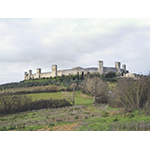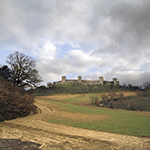Walls of Monteriggioni
The impression aroused by the vision of the citadel at the time of its greatest splendour must have been great. In his Divine Comedy (Inferno, canto XXXI, vv. 40-45), Dante compares the giants placed between the 8th and 9th circle of Hell to its two tall towers.
«for as, on its round wall, Montereggione
is crowned with towers, so there towered here,
above the bank that runs around the pit,
with half their bulk, the terrifying giants,
whom Jove still menaces from Heaven when
he sends his bolts of thunder down upon them.»
Founded by the Sienese between 1213 and 1219 as an outpost against the Florentines, in antiquity Monteriggioni was famed as an impregnable fortress; a fully merited fame considering that it fell only after the betrayal of a Florentine political exile in 1554. With a perimeter of 570 metres, the walls were interspersed with 15 quadrangular towers with battlements and bartizans (a type of wooden balcony that jutted out in the points of greatest defensive efforts), while externally, it was surrounded by a moat which was filled with coal and ignited in case of siege. Moreover, in correspondence to one of the two surviving entry gates, there appears to have been yet another defence structure, a rectangular-shaped ravelin (outpost). The entirety constitutes an excellent example of technical-military knowledge of the medieval period.
Passed down to our times almost intact (the towers were lowered in the 16th century to draw in line with the new firearms, though several were raised later), this splendid ancient village, every summer, evokes its glorious past. On the occasion of its medieval feast, all of the inhabitants don period costumes and interpret a specific character for several days. All signs of modernity, such as automobiles and electric energy, are banished, while legal tender is exchanged for "the Monteriggioni scudo", which makes it possible to savour the "ancient" flavours of the village’s typical products.
****************************
Texts by Elena Fani
English translation by Victor Beard
Last update 18/feb/2008





